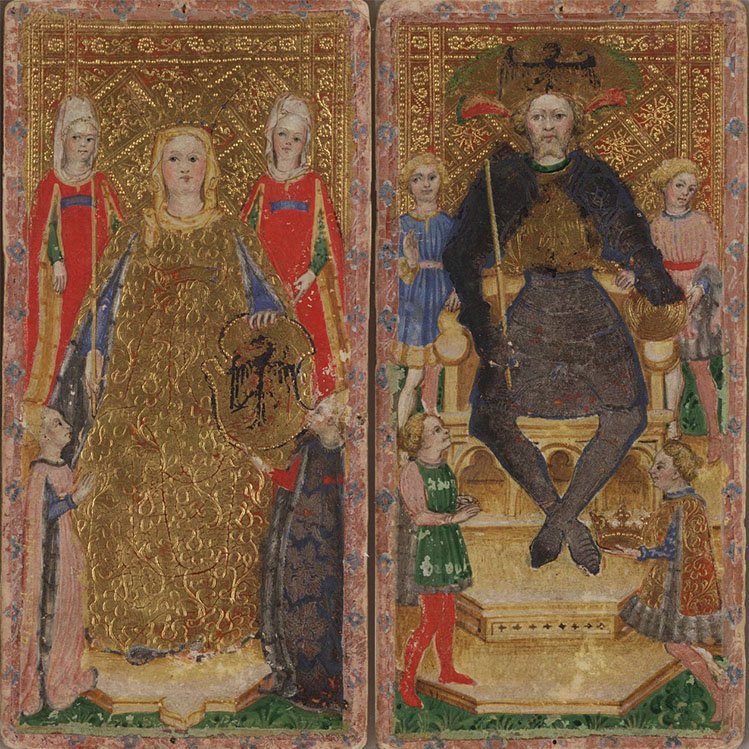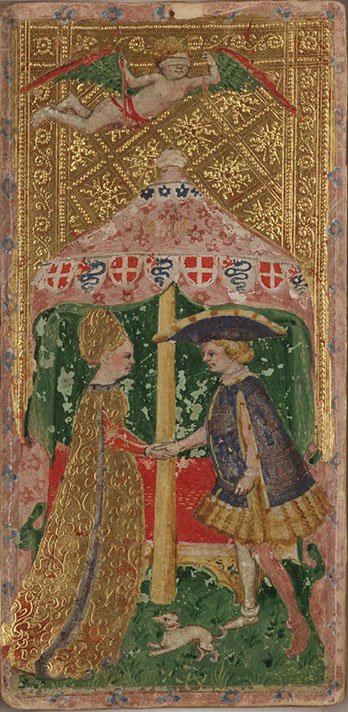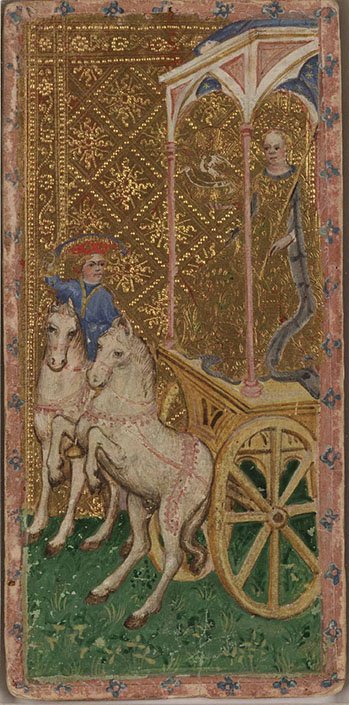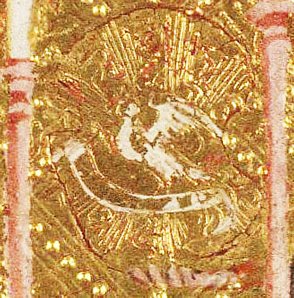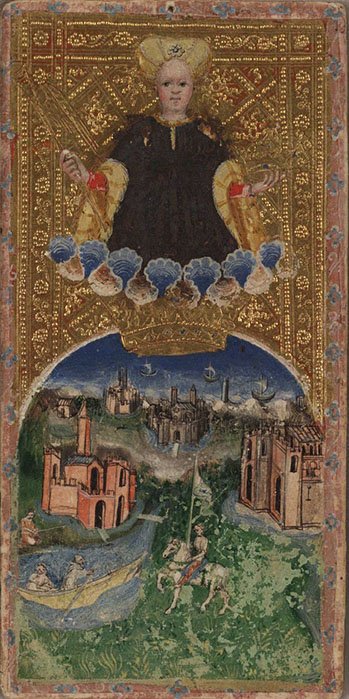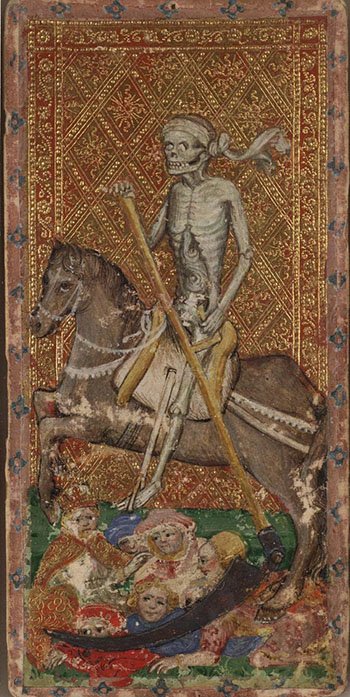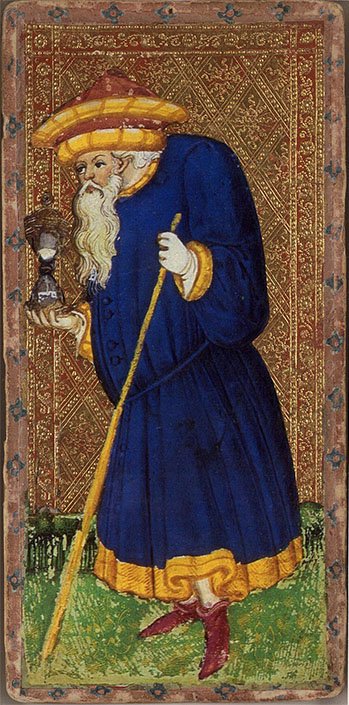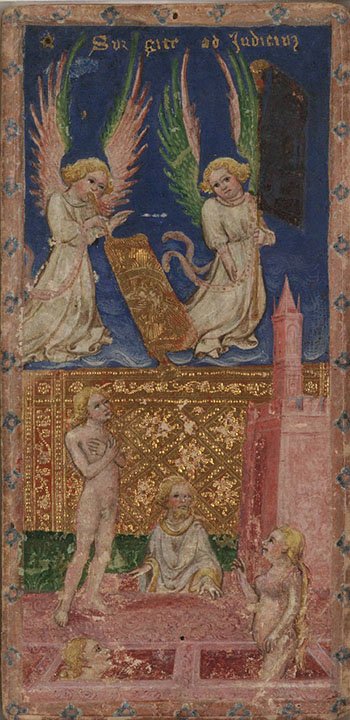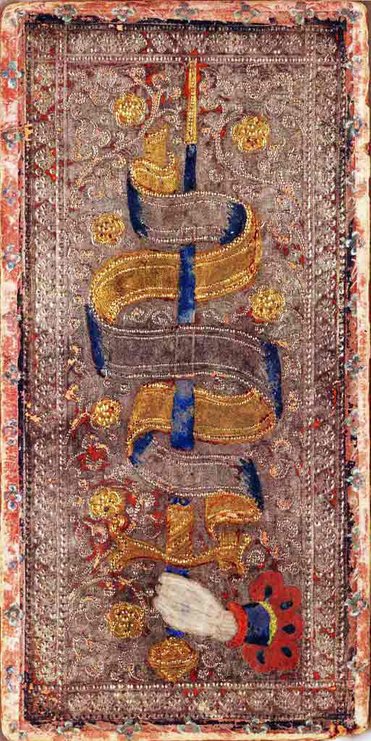THE TAROT WHEEL
THE VISCONTI DI MODRONE DECK - 5 SUITS OF 16 CARDS
Starting with the Michelino deck, the principle of a separate suit, trumping over the standard suit cards, was quickly adopted in the Italian courts. The birds used as suit symbols on the Michelino deck were not used elsewhere, other decks preferred the symbols inspired by the Mamlûk cards and reinforced by Western cultural heritage. Both in Ferrara and in Milan, the trump symbols evolved, and they influenced each other. In 1440/1441 Maria Bianca Visconti, daughter of Filippo Maria, stayed for six months at the court of Ferrara. At the occasion of New Year, Niccolo III, Marquis of Este offered her a set of fourteen illustrations, that might well have been fourteen illustrations corresponding to those who were used on the Trionfi decks. At that time, Bianca Maria was 14 years old. Niccolo III had many children and as has been suggested on the site Trionfi.com, many of them were probably present at the court when Bianca Maria was there. One of them was the then 10 years old Ercole, the later Duke Ercole I.
This whole gang had lots of time to amuse themselves and to play cards. The Este court produced their own printed cards since 1437. But also handmade cards were being made. In 1442, the account book mentions the purchase of a relative cheap Trionfi deck for the brothers Ercole and Sigismondo, in Ferrara this is the oldest entry mentioning a Trionfi deck.
Later that year, in October 1441, Maria Bianca marries to Francesco Sforza. Her father offered the couple a beautiful hand-painted card deck consisting probably of five suits of sixteen cards, sixteen trump cards and four suits of sixteen suit cards. Let us consider here the Trump cards, on other pages we will deal with the suit cards.
The surviving cards of this wedding present are known as the Visconti di Modrone (the last family who owned the deck) or the Cary Yale Visconti (named after the Cary collection at the Yale University, where the deck is conserved) Tarot. The surviving Trumps cards consist of the Emperor and the Empress, four Virtues (Faith, Hope, Charity and Strength) and five other cards. These five cards are especially interesting, while, as we will see, they refer directly to "I Trionfi", the famous poem of Petrarca. 11 out of the 16 allegorical figures (if they were 16 as I suppose) survived time. My interpretation of these cards and my guesses for the missing cards are detailed here below. Let us go slowly.
Every work in art has many sources of inspiration. During the fourteenth Century, Northern Italy has produced, among others, two works of literature that would have a tremendous influence on the later Renaissance Art. They are very similar, both describing in a hierarchical manner the battle between good and evil and the ascent to God. The oldest of them is the Commedia of Dante (many years later, Boccacio changed the name to the Divina Commedia). In the Commedia, Dante describes his fictional journey with Beatrice through Hell, Purgatory and Heaven, each of them consisting of 9 layers. The second work of literature is I Trionfi from Petrarca. In this poem, there are again three levels. As is described here below, an important source of inspiration for Petrarca was "the Republic" written by Plato where the Human Soul is described consisting of three levels. On every level, the Soul has to combat against its shortcomings while practicing a Virtue. In both poems, there is a red common thread through the text, the love for a lady, an unattainable love that will never be reached. For Dante, there is his love for Beatrice, for Petrarca, his love for Laura.
Petrarca served the Visconti family for eight years, from 1353 to 1361. Parts of his poem I Trionfi were written in this period. It was Galeazzo II Visconti, grandfather of Filippo Maria, who reigned during this time as Lord over Milan. As a result, the Visconti family was very familiar with the works of Petrarca. Hierarchy was of vital importance in the Late Middle Ages and the Early Renaissance. This expressed itself in many works of art, like the poem I Trionfi and the Michellino deck of cards. For his new deck, Filippo Maria probably wanted again 16 trumps in a hierarchical order. But this time no Roman Gods like in the earlier Michellino deck. Maybe he wanted that the main theme was the theme developed by Petrarca in I Trionfi. This theme should be completed by the Seven Virtues. But together with the six Trionfi of Petrarca, this gives only 13 cards, so 3 other cards should be added to allow for a deck with 16 Trumps.
Why do I believe, there were 16 Trump cards in this deck? The first card deck conceived for Filippo Maria Visconty, the Michelino deck, had 16 trump cards. No cards have survived, but their structure is very well documented. For Filippo Maria, 16 was a special number. In the Visconto di Modrone deck every suit has 16 cards, 10 pip cards, 3 male and 3 female court cards. With all those sixteens above, it seems logical to me that the Visconti di Modrone had also 16 Trump cards. In the same time, there was a development in Ferrara to have only 14 cards per suit, inclusive the trump suit. In conclusion, even if Milan and Ferrara did not agree about the number of cards per suit, nor about the subjects of the trump cards, at least they agreed that every suit had the same number of cards, including the trumps. For this reason, I believe that there were 16 trump cards in the Visconti di Modrone.
The I Trionfi sequence had 6 cards, 3 pairs of 2 cards. To arrive at 16 trump cards in the Visconti de Modrone, one pair was added below the card representing Love. This pair represented rulers on Earth, simple human that were easily trumped by the abstract expressions on the other cards. In adding the Empress and the Emperor (see the figure here below), this permitted to make a link between the Trumps and the different suits. The Emperor was accompanied by four boys, the Empress by four girls. The Emperor has the imperial eagle on his chest and hat. The dress of the Empress is covered with blossoms, used by Filippo Maria to indicate his own daughter, Bianca Maria. The girls on the Empress card emphasize that the Empress is a mother. This card represents the family and a mother, while the Empress is the undisputed head of the family. As such, this card had a strong message for the bride. On the card of the Emperor, we see a portrait of Sigismund, the last Holy Roman Emperor, who died in 1437. On this card, each of the boys represents one of the four traditional Kingdoms of the Holy Roman Empire. The Kingdom of the North, Germany. The Kingdom of the East, Bohemia. The Kingdom of the West, Burgundy and the Kingdom of the South, Italy. Remark that the lower left boy has written “A bon droyt” on his tunic, the device of the Visconti family. Filippo Maria Visconti recognizes and respects his place within the Empire. In the same way as each of the four boys on this card represents one of these Kingdoms, each suit is headed by a King and represents as such also one Kingdom.
With the six Trionfi of Petrarca the uncertainties begin. Patrarca was an independent poet, who lived in the same time as the grandfather of Filippo Maria, Galeazzo II Visconti. Galeazzo II managed to have Petrarca working for him several years at his court. In this time he started one of his great works, I Trionfi. I Trionfi was a poem in six parts, and it took Petrarca 18 years to accomplish it. At the Visconti library in Pavia, there was certainly a copy available, so Filippo Maria knew this work very well.
I Trionfi was one of the greatest works of the early Renaissance. The work was based on the classical philosophy of Plato, as described in his work "the Republic". In this work Plato describes how the human Soul is divided in three parts. Plato also describes the equivalence of human Society with the human Soul :
- The first part of the Soul is called the Soul of Appetite. This part of the Soul is tied to physical needs. Lust and desire are born in this part of the Soul. Plato recommends using the virtue of Temperance to master these needs. The equivalence in human society is the working class.
- The second part of the Soul is called the Soul of Will. The Soul is now master of its physical needs, and it is striving for great deeds and Fame. Plato recommends the use of Strength, equivalent to mental courage, to master this part of the Soul. The equivalents in human society are the warriors who are fighting in battles to protect the working class or to extend the territory of the State.
- The third part of the Soul is called the Soul of Reason. The Soul is now master of its deeds, and it is striving for Justice. Plato recommends the use of the virtue of Prudence to master this part of the Soul. The equivalence in human society is the ruling class.
Once the human Soul practices all three virtues, Temperance, Strength and Prudence, it automatically practices the fourth and most important virtue, the virtue of Justice.
Petrarca organized his poem as the human Soul striving for Justice. In his poem, there are the three levels of the Human Soul. On each level, he first described the vice that menaces the Soul. After the vice, he describes the virtue that manages to overcome this vice. On each next level, we have a vice that is stronger than the virtue on the lower level and again a virtue overcoming this vice. As a consequence, the full poem consists of six levels, three vices and three virtues, three pairs of a vice and a stronger virtue. They are presented as a triumphal procession, where each virtue/vice triumphs over the earlier vice/virtue. On the first level, we see the Triumph of Love. Love expresses physical love or sexual desire, so it is considered a vice. Love is triumphed by the Chastity (also called Modesty). People had to restrain themselves and reserve their real love for a single woman, even if their marriage was arranged for strategical reasons. As for Dante, his real love was reserved for Laura. Therefore, Chastity is a virtue. The correspondence in the work of Plato is the Virtue of Temperance. But alas, a new evil is popping up triumphing over Love -- Death, which will separate two people in love. Death in its turn is triumphed by Fame. If you have an exemplary life, you might become famous, and your fame will survive the day you die. This mental force, to become an exemplary hero, has its counterpart in Plato's work in the Virtue of Strength. The only evil force capable of triumphing over Fame is Time. If you wait long enough every memory will disappear. On its turn, Time will be triumphed by God's Eternity. Time can be triumphed by using the Virtue of Prudence. At the Last Judgment, Time will disappear and those who are judged positively will be eternally united with God. And with the Last Judgment, there appears the last of the four Virtues of Plato, the Virtue of Justice.
In the poem I Trionfi, on the lowest level we see the Triumph of the first Vice, the Triumph of Love. Love is clearly not spiritual love, as a vice, Love represents lust or sexual desire. In the poem, Love is a young man, nude and parading on a Chariot. On the corresponding card in the Visconti di Modrone we see two people, a lady and a man, shaking hands. The Lady has a golden dress, covered with flowers. The man is wearing a dark blue tunic, with on the tunic a fountain, the personal device of Francesco Sforza. They are standing under the protective cover of a parasol. The parasol is bordered with the blazons of the Visconti and the Savoy families. This parasol represents Filippo Maria Visconti and his wife Maria of Savoy. The bond between Filippo Maria Visconti and Maria of Savoy was a strategic one, there was no love in this marriage. On the parasol is written in golden characters the word “amor” (love, not visible on this scale). Above the parasol is flying Cupid, the blind and naked God of Love, and between the two people a small dog, symbol for fidelity. Amor, Cupid, fidelity, all of them are symbols for love.
But reality is something else, Filippo Maria was a cynical man, and he did express this on his cards. Filippo Maria had no false expectations. The couple represents his daughter Bianca Maria who is concluding a marriage agreement with Francesco Sforza. This agreement has the protection of her father, Filippo Maria Visconti and her stepmother, Maria of Savoy. Cupid is blindfolded and in a passive position. He is not shooting his arrows of love, there is no love in this agreement. The blindfolded Cupid symbolizes that love is blind. But the agreement is the opposite, it is concluded with the eyes wide open. The dog is for Filippo Maria a reference to his own wedding night. During this night, he heard a dog barking. For Filippo Maria, who was a very superstitious man, this was an awful sign. It was the first and the last time he slept together with his wife under the same roof. So let us repeat it, a marriage agreement between noble families in the Italian Renaissance had nothing to do with love, it was only concluded to get strategical advantages. In noble marriages, Love is a vice, you have to privilege the interest of State. So here, in this card, Love is already being conquered by Chastity (Modesty), represented in the next card.
Even in a marriage that starts with love, very often, when the couple gets older, sexual desire weakens and might even disappear. In some couples, love continues on another level, but many couples stay only together, because of the children or because they are happy with their life and don't want (or dare) to change. Physical love disappears and the Triumph of Chastity appears. Chastity (Modesty) is the triumph of intellect over emotion, a triumph that nobody really wants.
On the Chariot card, we see a beautiful young lady, sitting on a Chariot of Victory. She is wearing a golden dress with on the dress the stylized Piumay symbol. The Piumai is a crown from which branches of laurel and palm are rising. This was the personal device of Filippo Maria Visconti. The lady clearly represents Maria Bianca Visconti.
In her right hand, a golden disk representing a radiant sun. In front of the sun, a dove standing on a banner (Figure at right). The text is unreadable, normally there is written “a bon droyt”. The Dove in front of the Sun and standing on a banner with the text "a bon droyt" is the personal device of Gian Galeazzo Visconti, father of Filippo Maria, another hint that the lady represents Bianca Maria Visconti.
The Chariot symbolizes the Triumph of Chastity, the victory over lust and desire, with Bianca Maria Visconti representing this noble virtue. For modern people Chastity is not a virtue anymore, but in the Late Middle Ages and the Early Renaissance this was definitely different, and Filippo Maria Visconti was probably very pleased having his daughter representing this virtue.
The next evil force, Death, is clearly represented in the Visconti du Modrone (Figure at the right). We see a skeleton sitting on a gray horse, harvesting with his scythe the Souls of a King, a priest, common people, man and woman alike, he makes no difference. Everyone will obey, when his scythe is on work. On the head of Death we see a white scarf. This is not a blindfold, he does not need a blindfold, there are no eyes in the hollow holes in his head. The white scarf on his forehead symbolizes independence. This symbol is still widely in use today, as an example, we mention the flag of Corsica.
For this card there is no space for misinterpretations, its significance is loud and clear the Triumph of Death.
The Triumph of Fame
When people die, they do not disappear completely. The memory we have of this person, will stay with us. And the more famous the people were, the longer they will make part of our life. Jesus Christ died 20 centuries ago, Charlemagne 12 centuries, Filippo Maria Visconti 6 centuries, they are all still part of our life. We call this the Triumph of Fame.
Today, there is no card in the modern Tarot deck having an allegorical representation of Fame. But again, the Visconti di Modrone is not a Tarot deck. It is an ancestor of the Tarot, an early Trionfi deck. So it may have had different allegorical figures.
In the Visconti di Modrone deck, there is a card that most people call the World because of its resemblance with other Renaissance World cards (Figure at the left). But if we look closer, we see that there are differences and that the symbols are not the same. There is no representation of the World disk, an essential part for a card representing the World. We see in the foreground a knight on a horse, carrying proudly his standard. On the standard, something that looks like a snake, maybe the blazon of the Visconti family.
The Triumph of Death
Apparently he is coming back from a successful journey, a quest, a battle, it can be anything. In the background many cities and houses. The cities have walls, but for him, all the doors are open. In front of him, a river. On the river, a small boat. It looks like a ferry, transporting people from one side to the other side of the river. On the other side, a fisherman. Behind the cities we see a great sea, with a light tower and boats traveling.
Above this scenery, we see a Crown. From the crown a woman is rising, in her left hand another crown, and in her right hand a winged trumpet. The winged trumpet is a symbol traditionally used for Fame, and the crown symbolizes a royal reward for the exploit of the knight. My conclusion is that this card is not representing the World or whatsoever, no, here we have a clear representation of the Triumph of Fame.
Human life is nothing on a geological timescale, and one day will come that the civilization, as we know it, will disappear. Maybe another civilization will appear, but our heroes will be long forgotten. No Jesus Christ anymore, no Charlemagne, no Filippo Maria Visconti, all will have disappeared. This malicious force is the Triumph of Time. Nor in the Visconti di Modrone, nor in the modern Tarot decks, there is a card that could represent Time. But as we will see, the Hermit has changed over time. We find him back on two of the later handcrafted cards, the Visconti Sforza deck and the Charles VI deck. He has no lantern in his hand but an hourglass. An old man holding an hourglass in his hand is the classical way to represent Father Time. In other paintings representing the Triumph of Time, we see old men with crutches and wings. This is exactly the way the Hermit is represented on the Rothschild sheet, one of the surviving uncut sheets, conserved in Paris in the Ecole Nationale Supérieure des Beaux Arts (National Highschool for Fine Arts). And he is also presented like this in the Tarocchino decks, a Tarot like card deck made in Bologna. And on the Minchiate cards, we see an old man with an hourglass behind him. So, Time is definitely existing on the oldest Italian cards from the Tarot family.
Considering the apparent presence of all the other Trionfi described by Petrarca (we had four until now, the last card will be explained hereunder), the presence of Time in several later decks and the fact that probably five Trump cards are missing, the Triumph of Time is an excellent candidate to be one of these missing cards. If someone asked me to create a modern but complete copy of the Visconti di Modrone deck, I would certainly include an allegorical figure representing the Triumph of Time. In the figure at right, I have tried to reconstruct this card. The card shown here is a non-existing card. In fact, it is the representation of Time from the Visconti Sforza deck against the typical background of a Visconti di Modrone card. We see an old man with a hunchback and an hourglass in his hand, the usual allegorical representation of father Time.
The Triumph of Eternity
In Christian Faith there is no place for reincarnation (the rebirth of the Human Soul in a new body) but there is a place for eternal life. Eternal life is not time related, and the Last Judgment is just a symbol. A Soul that is unworthy for the Last Judgment, will be sent into the Purgatory to meditate about his behavior, before he can access Heaven. The last Judgment is at the entry of Eternity, so it does not take place at a certain moment. Any Soul, who deserves it, can have his Last Judgment the moment he leaves his temporal body behind. That is why the Roman Catholic Church can proclaim Saints, Souls whose lives were so exemplary that the Church officials believe that they are forever together with God.
After the Last Judgment, once in Heaven, Time is not existing anymore. It is the Triumph of Eternity. Again, for the Triumph of Eternity, we don't have any problems to find its representation in the Visconti di Modrone, here at the left. On this card, that we call today the Last Judgment, we see two angels, both with Trumpets carrying a banner. On the left banner the Dove and the radiant Sun, symbols of the Visconti family, and on the right banner a fountain, symbol of the Sforza family. We are in a cemetery and a bearded figure, probably representing Jesus, is resurrecting the dead. Above the angels is written in golden letters “surgir ad judicium” (rise for judgment). The judgment they receive will decide for them for Eternity. For this reason, this card is a perfect representation for the Triumph of Eternity.
A fact is, that after the appearance of this deck, the card game with trumps is systematically called the game with the Trionfi from Petrarch, or simply a Trionfi deck and that references to Trionfi deck appear everywhere. What is also a fact, is that the first appearance of the name Trionfi appears in Florence, one year before the creation of the Visconti di Modrone deck. This is strong evidence, that other decks (printed or hand-painted) existed before the creation of the oldest-known Trionfi decks. I believe that the Visconti di Modrone deck is probably not only inspired by the Michelino deck, but also by other existing decks, of which no examples are surviving. The only thing that is certain, is that in the middle of the 15th Century, the structure of the Trionfi decks was not yet fixed, and that several variants existed.
Until now we have seen eight cards, the Emperor, the Empress and six cards representing the Trionfi of Petrarca. We found one of the five missing cards, the Triumph of Time. But what about the other eight Trump cards. I have stated that the Visconti di Modrone probably had 16 Trump cards, so there are still four cards missing. Among the four remaining cards that are present are the three Theological Virtues, Faith, Hope and Charity.
These three cards are not existing on any modern Tarot deck. However, they are also present on the Michiate deck, that has 41 Trumps. The last card in the Visconti di Modrone deck we can identify is the Virtue of Strength. She is represented in the same way as on modern decks, as a lady who is opening without effort and with her bare hands the mouth of a Lion. Because all the Theological Virtues are present, as well as the Cardinal Virtue Strength, I think it's very probable that the other Cardinal Virtues, Temperance, Justice and Prudence were also present. This solves in one hit, the question about three of the missing Trumps.
But there is still one Trump missing. If we group the Emperor, the Empress and the six Trionfi together, then there should be another card that would fit nicely together with the Virtues.
The strongest reason not to choose the Pope (or the Popess) as an allegorical figure completing the Virtues, was the fact that indirectly the Pope was already represented in the Theological Virtues, who represents indirectly the Trinity. The Virtue Faith represents the Holy Ghost and Religion. The Virtue of Hope represents Jesus (represented on Earth by the Pope) and the Virtue of Charity represents God the Father. So if the Virtues Faith and Hope are present, nor the Pope, nor the Popess, will appear in the same deck. In the Minchiate deck, the Theological Virtues have been added, but the Pope and Popess have been removed. We clearly need to look further.
Present in the Visconti de Modrone are Love and Death, two of the three blind forces acting upon human life. The third blind force, Lady Fortune, would be a good candidate for occupying the place of the last missing card. Effectively, Fortune is present in all later Trionfi and Tarot decks. It is one of the two surviving Trump cards in the Brere Brambilla Visconti, another Trionfi deck commissioned by Filippo Maria. For this reason, I consider Fortune (or Destiny) as an excellent candidate for the last missing card, but it could also be the Fool, or another card.
If we accept the arguments above, the structure of the Visconti di Modrone might have been as given in the table here below:
(9) Empress | (10) Emperor | (11) Love | (12) Chastity (Chariot) | (13) Death | (14) Fame (World) | (15) Time (Hermit) | (16) Eternity (Last Judgment) |
(1) Destiny (Fortune) | (2) Faith | (3) Hope | (4) Charity | (5) Temperance | (6) Strength | (7) Prudence | (8) Justice |
So in this proposition we have two series of eight cards:
- Series 1 - The Wheel of Fortune (or the Fool, or another card) plus the seven virues
- Series 2 - The Empress, the Emperor and the six Trionfi of Petrarca
The beauty of this arrangement is that the first series of eight cards finishes with the Justice on Earth and that the second series of eight cards finishes with the Justice of God. Looking closer, we might even distinguish four series of four trump cards, each maybe linked to a specific suit, just as in the Michellino deck:
- Series 1 - Virtues given by God - Fortune (or Destiny) and the three theological virtues ending with Charity - Cups
- Series 2 - Virtues that one should acquire - the four cardinal virtues ending with Justice - Swords
- Series 3 - Human life - the Empress, Emperor, Love and the Chariot (Chastity) - Coins
- Series 4 - Afterlife - the Trionfi of Petrarca from Death to Eternity - Batons
An important particularity of the Visconti di Modrone is, that it has 6 court cards in every suit, 3 male figures and 3 female figures. The Mamlûk cards had only three male characters for the court, that were translated in a King, a Knight and his Squire. On the Visconti de Modrone, three female characters were added, a Queen, a Lady riding a horse and a servant. Filippo Maria Visconti (if he was the driving force behind the deck), was maybe the first figure in European history, who expressed himself so clearly for the parity of sex.
Except for the suit symbols being the same, every court figure within the same suit was having the same heraldic symbols on its clothes. The Dove and Sun, Symbols related to Gian Galeazzo Visconti, appear on the suit of Coins. The Piumai related to Filippo Maria Visconti himself, appears on the suit of Cups. Many blossoms on a dress, that might have been related to Bianca Maria Visconti, appear on the suit of Swords. Finally, the fountain of life, a symbol used by Francesco Sforza, appears on the suit of Batons. All these heraldic symbols are of no use for playing the Trionfi game, but they are important to understand where and when the game was made. Here, they are symbols for the marriage between members of the Visconti and the Sforza families.
The Visconti di Modrone is an exceptional deck in many ways. The Trump cards have a particular structure, the Court cards are astonishing with their parity between male and female representations, and also the pip cards have some very peculiar characteristics. On the Visconti di Modrone, the Mamlûk polo-sticks are replaced by two different symbols, Arrows and Scepters, Arrows on the numbered cards and Scepters on the Court cards.
Also, the suit of Swords has a surprising feature. On the Ace of Swords, a hand is holding his sword upwards in the air. Remark that this hand is hardly visible on the reproduction of the deck made by Stuart Kaplan and commercialized by US Games Systems. The card is almost always illustrated upside down (even on the site of the Beinecke Library, where the original card is conserved), with the sword pointing downwards. In the reproduction of this card, here on the right side, I reinforced this hand with some additional coloring. The card now reminds us strangely of the one of Swords on the Tarot of Jaques Vievil.
The pip cards of the two known decks commissioned by the Duke of Milan, Filippo Maria Visconti, are particularly beautiful. There where the court and trump cards have gold hammered backgrounds, the pip cards have silver hammered backgrounds. All pip cards make extensively use of gold and azure, considered in that time as royal colors.
